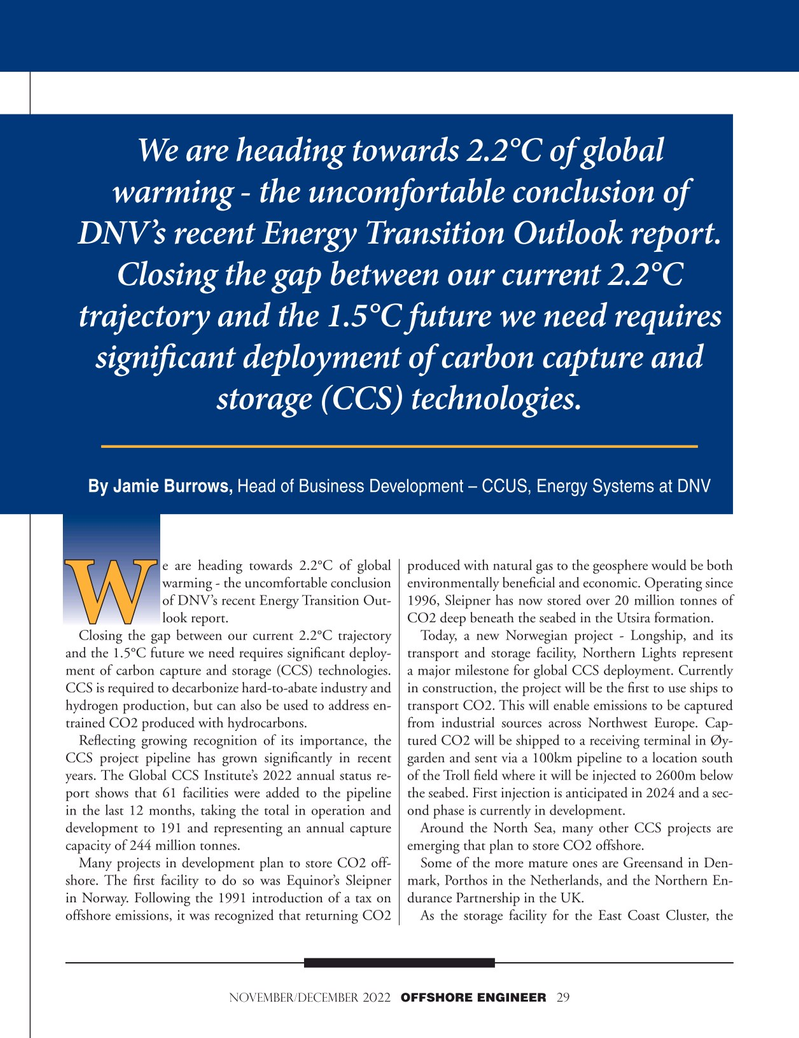
Page 29: of Offshore Engineer Magazine (Nov/Dec 2022)
Read this page in Pdf, Flash or Html5 edition of Nov/Dec 2022 Offshore Engineer Magazine
We are heading towards 2.2°C of global warming - the uncomfortable conclusion of
DNV’s recent Energy Transition Outlook report.
Closing the gap between our current 2.2°C trajectory and the 1.5°C future we need requires signifcant deployment of carbon capture and storage (CCS) technologies.
By Jamie Burrows, Head of Business Development – CCUS, Energy Systems at DNV e are heading towards 2.2°C of global produced with natural gas to the geosphere would be both warming - the uncomfortable conclusion environmentally bene?cial and economic. Operating since of DNV’s recent Energy Transition Out- 1996, Sleipner has now stored over 20 million tonnes of look report. CO2 deep beneath the seabed in the Utsira formation.
W
Closing the gap between our current 2.2°C trajectory Today, a new Norwegian project - Longship, and its and the 1.5°C future we need requires signi?cant deploy- transport and storage facility, Northern Lights represent ment of carbon capture and storage (CCS) technologies. a major milestone for global CCS deployment. Currently
CCS is required to decarbonize hard-to-abate industry and in construction, the project will be the ?rst to use ships to hydrogen production, but can also be used to address en- transport CO2. This will enable emissions to be captured trained CO2 produced with hydrocarbons. from industrial sources across Northwest Europe. Cap-
Re?ecting growing recognition of its importance, the tured CO2 will be shipped to a receiving terminal in Øy-
CCS project pipeline has grown signi?cantly in recent garden and sent via a 100km pipeline to a location south years. The Global CCS Institute’s 2022 annual status re- of the Troll ?eld where it will be injected to 2600m below port shows that 61 facilities were added to the pipeline the seabed. First injection is anticipated in 2024 and a sec- in the last 12 months, taking the total in operation and ond phase is currently in development. development to 191 and representing an annual capture Around the North Sea, many other CCS projects are capacity of 244 million tonnes. emerging that plan to store CO2 offshore.
Many projects in development plan to store CO2 off- Some of the more mature ones are Greensand in Den- shore. The ?rst facility to do so was Equinor’s Sleipner mark, Porthos in the Netherlands, and the Northern En- in Norway. Following the 1991 introduction of a tax on durance Partnership in the UK. offshore emissions, it was recognized that returning CO2 As the storage facility for the East Coast Cluster, the november/december 2022 OFFSHORE ENGINEER 29

 28
28

 30
30